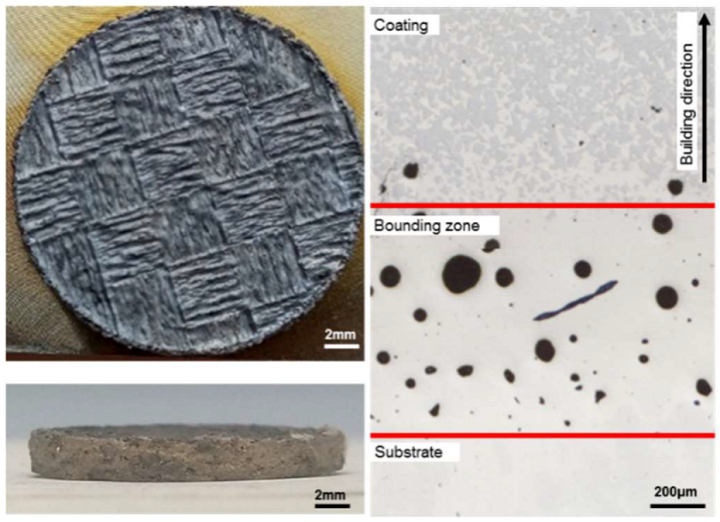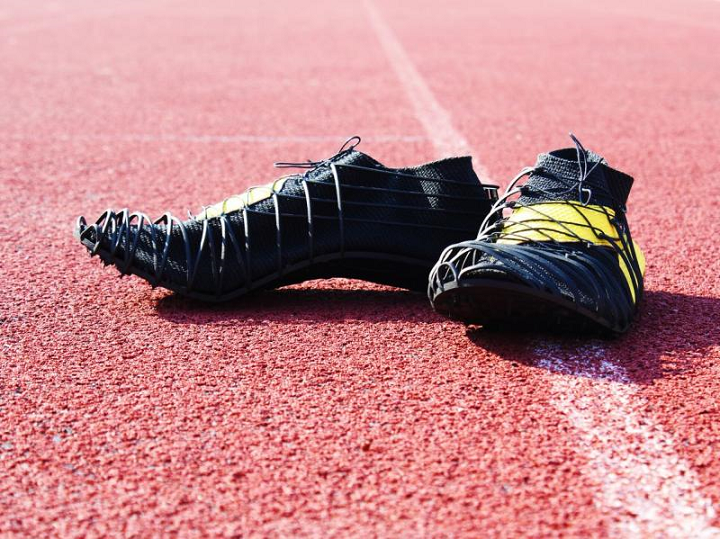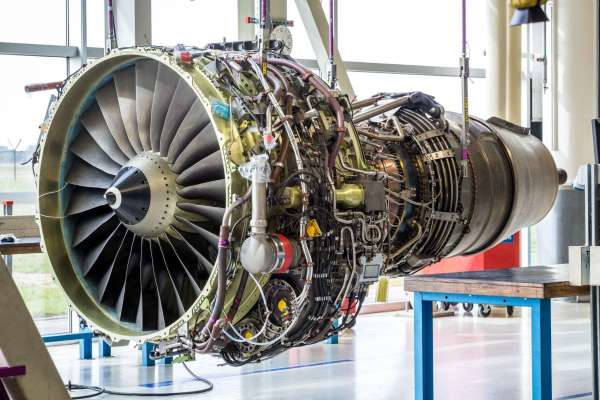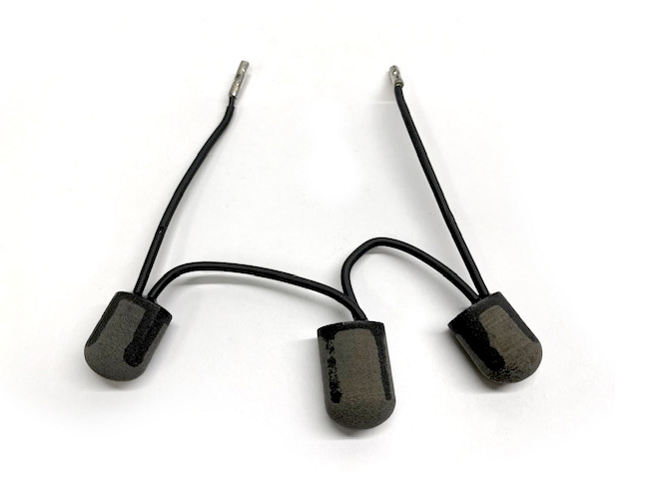Today’s 3D Printing News Briefs is a little bit of everything, starting with a research paper on 3D printing tungsten carbide surfaces with extreme wear resistivity. Moving on, a runner partnered with CRP Technology to 3D print customized athletic track shoes, and Optomec delivered a $1 million metal 3D printer for use in turbine repair. Finally, Sinterit published a case study showing how its Lisa PRO was used to help a company called Nabson produce small run parts and prototypes with better accuracy.
3D Printing Tungsten Carbide-Coated Steel Surfaces

Images of a printed WC/Co specimen: top view (top left) and side view (bottom left). The right panel depicts the cross-section where the three zones of growth can be identified.
A team of researchers from Aalen University in Germany published a paper, “Additive Manufacturing of Tungsten Carbide Surfaces with Extreme Wear Resistivity,” which is focused on their additive manufacturing process to produce wear-resistive tungsten carbide (WC) coatings. Laser powder bed fusion (LPBF) technology creates solid metal components by selectively exposing successive powder layers to a laser beam, but the high energy input from a laser on a very small area, paired with rapid cooling, can cause high temperature gradients, which then lead to residual stress and major deformations; that’s why LPBF technology uses support structures during printing and heat treatment post-print, the latter of which helps meet the demands of wear resistance. When processing conventional sintered materials, like WC, using LPBF, local under-carbonization can take place, and most coating processes, like vacuum deposition and electroplating, take a long time and only achieve small thicknesses of less than 10 microns. That’s why the Aalen team wanted to come up with a better solution, which is detailed in their study.
The abstract states, “Steel surfaces have been coated with Co-based tungsten carbide (WC) in an additive printing process. This process leads to compact and extremely mechanically stable surfaces. We performed tribological measurements using WC counter bodies under dry conditions and severe mechanical load. Low coefficients of friction, even for rough surfaces, were found and the resulting wear rates were extraordinarily small, even when compared to high-quality PVD film with a similar composition. These findings suggest a wide field of application for this novel preparation process for wear-resistive surfaces.”
3D Printed Carbon Fiber Spike Shoes
Venetian middle-distance runner Miro Buroni created a customized athletic track shoe, also called a spike shoe, called the Pleko, and worked with Italian sportswear and footwear manufacturing Diadora and CRP Technology to 3D print the midsole, outsole, pins, and ribbing of the shoe—in a single unit—in order to enhance the shoe’s performance. Diadora took a 3D scan of an athlete’s foot, and then performed a biomechanical analysis of running and footing, while CRP Technology offered its Windform SP carbon fiber-filled composite material and PBF process to build the shoe’s supporting structure. The material offers strong mechanical properties, like flexibility and resistance to deformation, which are very important for track shoes.
“Windform SP guarantees excellent resistance even in very thin thicknesses; this feature allowed me to create spike shoes with a perfect foot envelopment that facilitates an increase in comfort and enhanced performance,” Buroni said.
“Thanks to the pins under the outsole, the ‘cage’ in Windform SP allows the athlete to develop as much strength as possible, without losing energy. I positioned the deepest pins in the points of superior pressure of the feet against the ground. I also put smaller studs in other parts of the outsole: these studs are on a equal basis essential for the stability of the track shoes.
“The design and manufacturing technologies, combined with the Windform SP and its mechanical characteristics, made the Pleko track shoes highly innovative, taking the whole project to the highest level of customization and specialization.”
Optomec Delivers Metal AM Systems for Turbine Production Repair
Moving on, Optomec has announced the delivery of a $1 million multifunctional metal 3D printer to one of its long-standing customers—a top supplier in the worldwide aviation engine Maintenance Repair and Overhaul (MRO) market, which already has more than five other Optomec metal AM systems it’s using to repair a range of aircraft engine turbine components, in addition to industrial gas turbines. Optomec’s proprietary process uses adaptive software, advanced machine vision, automation, and on-the-fly laser power adjustment to repair and add metal to worn engine components, which restores them to their original geometric specifications. The company’s printers use Directed Energy Deposition (DED) technology, and the machine that was just delivered combines two turbine repair operations that are normally performed manually, which will improve the consistency and quality of the flight-critical procedures and lower the cost of engine overhauls.
“There are really three advantages to using the Optomec AM process for repairing turbine components. First of all, it saves time and cost relative to manual repairs. Secondly, it requires far less heat input, so the base metal is far less affected by the repair,” explained Jamie Hanson, Optomec’s VP of Business Development. “Finally, because the adaptive AM process adds less repair metal, the downstream machining costs are drastically reduced.”
Sinterit & Nabson Case Study
Finally, NABSON Inc., which manufactures products for the power, transportation, communication, and defense industries, purchased a dual extruder FDM 3D printer two years ago to speed up new product R&D and develop one of its product lines. The endeavor was successful, and NABSON decided to expand its AM capability with the addition of an SLS 3D printer that could more accurately produce prototypes and small run parts; after plenty of market research, the company chose Sinterit’s LISA PRO. As the case study details, NABSON was asked to install a series of thermal switches in one product line, which would shut down power to the aircraft if the connector overheated, and the switches had to be encased in epoxy for their protection. The LISA Pro was used to create an epoxy-filled housing unit for the switches, and because NABSON manufactured the part in-house, the company estimates it saved nearly 50% of the cost per sleeve, and also had the option to modify the design as much as necessary. Additionally, the unit’s thinnest wall measurement at the corners was 0.6 mm, so NABSON definitely got the accuracy it was looking for.
Sean Higgins, Manager of Organizational Effectiveness, Nabson USA, said, “In a three-week period, we were able to print, test, and modify over 20 designs.
“In order to keep up with our production demand, we have been operating the Lisa PRO almost 7 days a week for the past couple of months, without incident, and produced over 1500 sleeves.”
Subscribe to Our Email Newsletter
Stay up-to-date on all the latest news from the 3D printing industry and receive information and offers from third party vendors.
Print Services
Upload your 3D Models and get them printed quickly and efficiently.
You May Also Like
The Market and Industry Potential of Multi-Material 3D and 4D Printing in Additive Electronics
Additive manufacturing leverages computer-based software to create components for products by depositing either dielectric or conductive materials, layer by layer, into different geometric shapes. Since its birth in the 1980s,...
3DPOD 262: Bio-inspired Design for AM with Dhruv Bhate, Arizona State University
Dhruv Bhate is an associate professor at Arizona State University. There, he looks at structures, materials, and design. Previously, he worked at PADT as well as in the semiconductor and...
3DPOD 261: Tooling and Cooling for AM with Jason Murphy, NXC MFG
Jason Murphy´s NXC MFG (Next Chapter Manufacturing) is not a generalist service; instead, the company specializes in making tooling. Using LPBF and binder jet, the company produces some of the...
3DPOD 260: John Hart on VulcanForms, MIT, Desktop Metal and More
John Hart is a Professor at MIT; he´s also the director of the Laboratory for Manufacturing and Productivity as well as the director of the Center for Advanced Production Technologies....



































